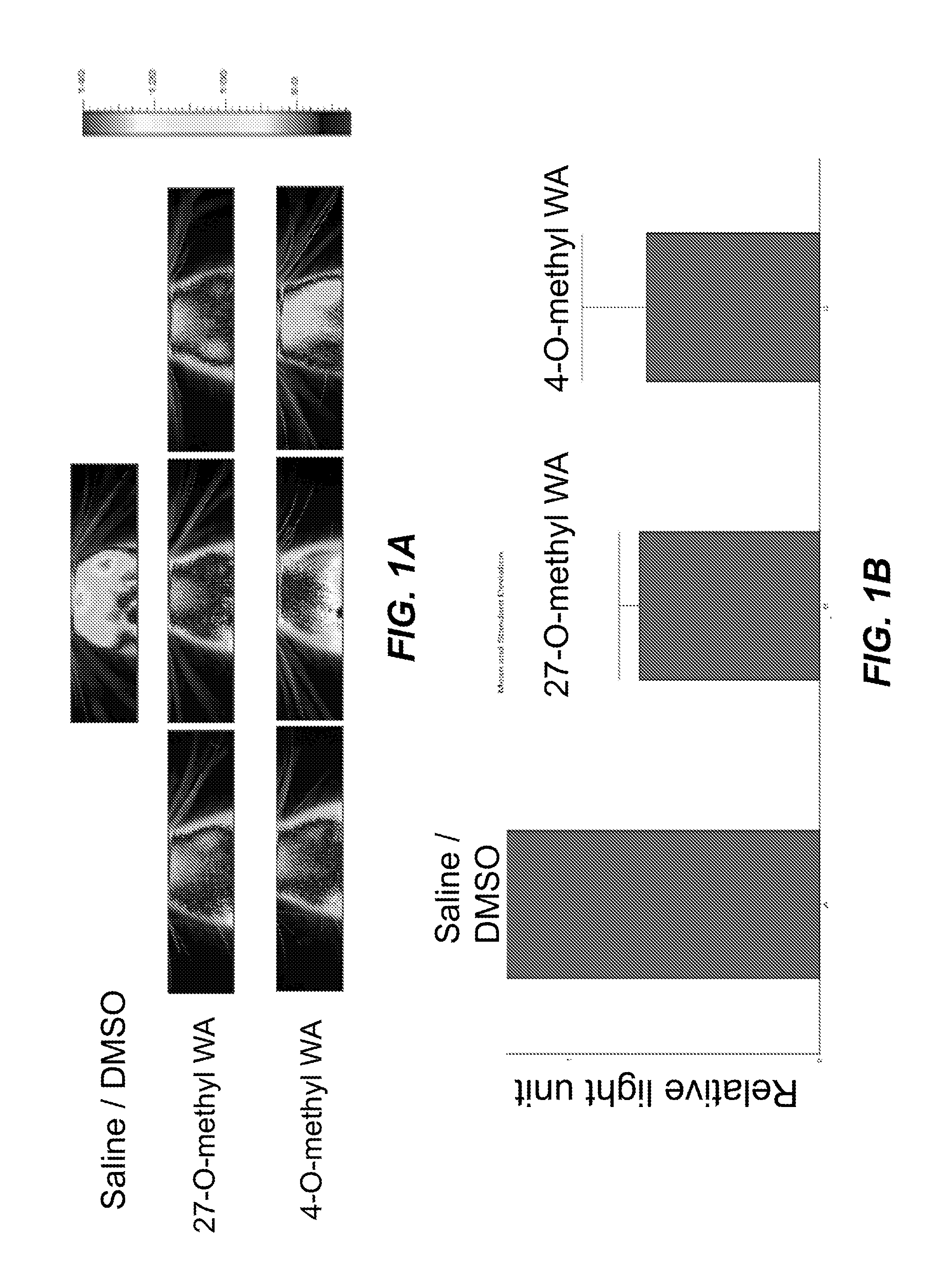Withanolides useful for the treatment of neurodegenerative diseases
a neurodegenerative disease and withanolide technology, applied in the direction of steroids, organic chemistry, medical preparations, etc., can solve the problems of paralysis and death, progressively impairing the individual's ability to control voluntary muscle movement, and prone to rapid progress
- Summary
- Abstract
- Description
- Claims
- Application Information
AI Technical Summary
Benefits of technology
Problems solved by technology
Method used
Image
Examples
example 1
Preparation of WA Methyl Ether Analogs from WA
[0112]
Preparation
[0113]150 mg of Withaferin A (available from Sigma-Aldrich Canada) (WA 1) were treated with sodium hydride in methyl iodide. The reaction produced a mixture of both mono-methylated compounds and di-methylated WA. The reaction mixture was filtered to remove excess sodium hydride and sodium iodide. The filtrate was dried and the residue re-dissolved in dichloromethane. The resulting solution was chromatographed on a silica gel column. Fractions containing the mono-methyl ethers (1 and 3) and dimethyl ether (4) were combined and the compounds separated by reversed phase chromatography.
[0114]Pure fractions of each compound were pooled, concentrated, extracted into dichloromethane and dried. Approximately 5-10 mg of each compound was thus obtained, each as a white solid. Spectroscopic data of these compounds are provided in Table 1 below.
TABLE 1m / z∂ ppm (CDCl3)Compound[M + H]+H-4H-27aH-27bOH-4OH-274-OMe27-OMeWithaferin A (1)4...
example 2
Brain Bioluminescence in GFAP-Luciferase Mice Exposed to LPS
[0115]Two of the novel withanolides were tested for their therapeutic activity in vivo using a transgenic mouse model. Transgenic GFAP-luciferase mice generated in the laboratory of Dr. J. P. Julien were used to assess the ability of the withanolides to inhibit astrogliosis associated with inflammation induced by lipopolysaccharide (LPS) exposure. In vivo bioluminescence imaging was performed to asses the inflammatory response in the cranial region. A decrease in bioluminescense signals in the evaluated region in comparison to the control (saline) indicated that the withanolides had crossed the blood brain barrier and subsequently inhibited gliosis.
[0116]Withanolides [4-O-methyl withaferin A (4-O-methyl WA) and 27-O-methyl withaferin A (27-O-methyl WA)] were diluted in 100% dimethyl sulfoxide (DMSO) at a final concentration of 2 mg / ml. GFAP-luc transgenic mice were used to test in vivo the efficacy of these analogs. In thes...
example 3
[0119]Novel withanolides inhibit NF-κB reporter activity in BV2 microglial cells stimulated with LPS. The withanolides 4-O-methyl WA, 27-O-methyl WA and 4,27-O-dimethyl WA were tested for their ability to inhibit NF-κB activation. An NF-κB specific luciferase reporter system in BV-2 microglial cells was first established. This cell line was generated by stable transfection of BV-2 cells with stable insertion of a luciferase reporter 4 kBwt luciferase plasmid and subsequent selection with hygomycin. LPS was used to stimulate NF-κB activity in these cells. Twenty-five thousand hygromycin B-resistant BV-2 cells were seeded per well in 24-well dishes and allowed to adhere overnight. The next morning, the culture medium (DMEM+10% FBS) was removed and 1 ml of fresh medium (DMEM without FBS) added to each well. The stock solutions of withanolides (2 mg / ml in DMSO) were diluted in 1×PBS to various concentration (0.05 to 5 uM) and added to the wells. LPS was added one hour later at a final c...
PUM
| Property | Measurement | Unit |
|---|---|---|
| concentration | aaaaa | aaaaa |
| concentration | aaaaa | aaaaa |
| concentration | aaaaa | aaaaa |
Abstract
Description
Claims
Application Information
 Login to View More
Login to View More - R&D
- Intellectual Property
- Life Sciences
- Materials
- Tech Scout
- Unparalleled Data Quality
- Higher Quality Content
- 60% Fewer Hallucinations
Browse by: Latest US Patents, China's latest patents, Technical Efficacy Thesaurus, Application Domain, Technology Topic, Popular Technical Reports.
© 2025 PatSnap. All rights reserved.Legal|Privacy policy|Modern Slavery Act Transparency Statement|Sitemap|About US| Contact US: help@patsnap.com



